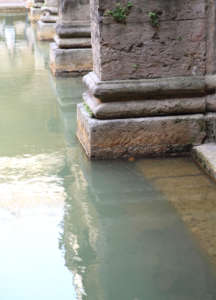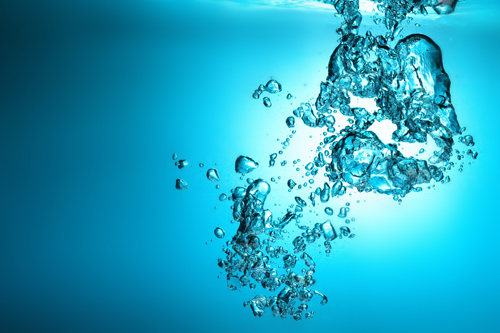A world without water is impossible to imagine because…well, because we wouldn’t be here to imagine it. Water is essential to the existence of every living thing. It hydrates. Cleans. Purifies. Calms. Invigorates. You can swim in it, soak in it, float on it…even skate away on it when the temperature allows.
It’s no wonder that water has so many positive connotations for us. It was our first comfort zone: a 98.6-degree immersion for about 9 months. Our liquid home in the womb was the most protective environment we will ever know.

Like an inborn instinct, our affinity for water continues through our lives. And the benefits of our relationship to H2O are both internal and external.
Water As Healer Takes Many Forms: Gas, Liquid, and Solid
Our need to consume water—a common recommendation is eight eight-ounce glasses a day—is pretty logical, since our bodies are about 75% water. We need water to rehydrate ourselves as well as to flush out toxins.
But the liquid version is only one way this elixir of life serves our bodies. Steam detoxifies us, by opening our pores and allowing us to sweat out the bad stuff. This is hardly breaking news; heat and steam have been used to purify the body for over two thousand years. Today, people continue to enjoy the rejuvenation of hot springs and mineral baths around the world.
Purification provided by steam or heated water is especially important for the brain. Industrial chemicals, pesticides, and heavy metals such as arsenic and lead that enter the body can compromise thinking, perception, mood, and behavior. A session in the steam bath or sauna can eliminate up to 30% of bodily waste via perspiration to promote greater well-being in mind and body.
Send the thermometer in the other direction and water serves our health in a different way. I know this from personal experience after many years of icing my bad knees following exercise to prevent inflammation. Making ice my post-workout companion has allowed me to bypass anti-inflammatory medications or other painkillers. Therapy straight from the freezer has kept me active and largely injury-free, even though I have almost no cartilage left in either knee.
Water As Relaxing Soundtrack and Soothing Backdrop
The sounds of moving water are often used as a background for meditation and massage, or as “white noise” to block out inharmonious distractions. Water sounds have proven beneficial for more serious therapy as well—everything from relieving stress in recovering alcoholics to calming down mothers going through labor.

How do water sounds affect human physiology? Results are inconclusive, but a study conducted in 1997 by Dr. Lee S. Berk of Loma Linda University offers insights. Dr. Berk had patients suffering from cancer and chronic pain watch a videotape that included at least 15 minutes of various water sounds (ocean, waves, waterfall, creek, birds bathing in water). As they watched and listened, the group experienced a 20 to 30% reduction in stress hormones such as epinephrine and cortisol. (Elevated levels of these hormones raise blood pressure, increase blood sugar level, and suppress the immune system.)
Images of water can alleviate anxiety as well. In a 1990 study of patients awaiting open-heart surgery in a Swedish hospital, patients were randomly selected to look at one of four scenes: open water, a forest scene, abstract art, or a blank wall. Guess which group experienced the least anxiety after their operations?
Based on findings such as these, it’s no surprise that interest in fountains for the home has surged like a geyser in recent years. People have discovered the value of using these “calming ponds” to create environments of serenity and relaxed concentration.
Water As a Personal Oasis
For each of us in our own way, water is also our special escape from it all. Some of us find serenity sitting on a sandy beach, watching the waves roll in, feeling connected to a timeless cycle of nature. Others are invigorated by sailing on the bounding main, as wind and water merge forces on our behalf. Others prefer the self-propulsion of a bracing swim. My oasis is an unspoiled lake outside my cousin’s cabin in the Maine woods. Slicing through the mist in a kayak on a crisp morning is my clearest route to earthbound nirvana.
Research by landscape designers and environmental psychologists has shown that the mere sight of water triggers pleasant feelings (as long as the water is not tainted). When presented with images of different natural landscapes, people have reported that large, calm bodies of water give them the greatest feelings of tranquillity.
So let’s raise our glasses in a toast. To water!
To learn about a distinctively interactive experience with water, be sure to read Duane Stapp’s enlightening review of Rain Room at the Museum of Modern Art in New York City.
What’s your favorite water scene? Tell us in the comments section below.




2 Comments
Holly Scott
Your comments about using ice on injuries to prevent inflammation made me remember my days of taking my daughters to athletic tournaments where they played two strenuous games in one day.
The coach required that each girl take an ICE bath between games. A parent volunteer was designated the ICE Parent. This parent was responsible for filling about 8 bathtubs in the player’s hotel rooms with ice, to be ready when the players returned after the first game.
Each player sat in the tub of ice for 6-8 minutes. You can imagine the squeals and other sounds that came from these bathtubs. Even with the suffering, the players all agreed the ICING was beneficial and enabled them to more quickly recover from the first game. The role of the ICE Parent volunteer lives on.
Ed Decker
I love your description of “ICE parenting.” Thanks so much for sharing, Holly!